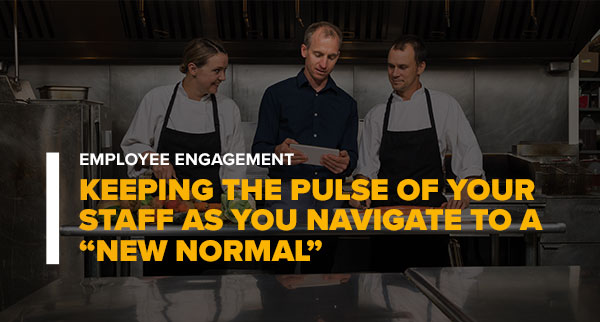I’ve been discussing the process of bringing back staff with management in hotels and other service businesses who are in the early stages of re-opening. In almost all these conversations, when the issue of employee engagement comes up someone makes the comment, “staff are going to be so relieved to be back to work that everyone is going to be engaged.”
It’s tempting to believe this – and it may be true when staff members first return – but this is a complex situation. Making that assumption may backfire if it takes your finger off the pulse of employee attitudes and feelings.
Employees may be returning to familiar turf as businesses re-open, but substantial changes have occurred. The building, rooms, and restaurants all look the same on the outside, but due to COVID-19, changes have occurred inside that dramatically impact everyone’s experiences. There are new safety processes, new federal, state, and local requirements, and new expectations for interacting with both guests and fellow employees.
This level of uncertainty in our work and personal lives can lead to significant psychological and emotional strain. In general, people can handle change, however, most people do not handle uncertainty well. Numerous studies have demonstrated that the psychological effects of uncertainty can range from intensifying emotional reactions, to anxiety and depression, or more serious mental health issues.
You don’t have the same business you had just a few months ago – and your employees don’t have the same lives they had either. While there is no playbook for navigating this new landscape, it is paramount to make the right moves as you traverse to a “new normal”.
Engage in Proactive Communication
Great leaders know that frequent, consistent, and transparent communication is the most important way to ensure employees feel more secure, especially during times of turmoil. Proactively communicating with your employees in this fluid situation helps provide certainty in this uncertain time.
Take the time to understand their circumstances at home. Coming back to work may mean they are dealing with childcare challenges because summer programs have been cancelled, or they have had to change their living arrangements to socially distance from aging parents. Even just asking “How are you feeling today?”, can make an employee feel more valued.
Solicit Honest Feedback
Getting specific feedback from staff about how the company is managing as quarantines are lifted, is equally important. Creating an environment where staff are encouraged to be honest with their feedback is critical, however, you are not likely to obtain their true, honest feelings as you would with an anonymous survey.
With all the changes, your annual survey results from last fall, or even this past February, are out of date and out of touch with what your employees need now. Up to date data is crucial to guide your decisions and the changes you must make to lead your employees and your guests to feel as comfortable as possible.
Many companies avoid employee engagement surveys during stressful and challenging times. That is a mistake. Employee engagement is not about popularity and making sure everyone is happy in their work environment, it is about finding out what changes need to be made and where improvements can happen to increase their engagement in their job. No job or company is perfect, so if you are only surveying your employees during good times, you are skewing your results and not really using engagement measures as a tool. The great benefit to measuring employee engagement is uncovering issues and finding strategies to correct them.
Frequency Matters
Consumer sentiment is evolving, guidance from the CDC and other experts is being updated regularly, political opinions vary wildly – and your staff are being exposed to this daily. During this fluid time, it is even more critical to survey your employees frequently. Doing quick pulse-checks allows management to make small changes swiftly and consistently based on the fluctuation in employees’ needs and feelings over the coming weeks and months.
Employee surveys are truly an essential tool right now. When you survey your employees during disruptions and challenging times, it shows you are committed to them and their welfare.
Additionally, most customer problems have an employee tie which is why the best and most advanced employee-centric companies have the highest customer satisfaction. Therefore, if you can consistently measure your employees’ engagement and what motivates them to be more engaged, you can adjust quickly and gain the trust of both your employees and your customers.
When you obtain and utilize accurate, frequent employee feedback to plot out your next moves, your business, your guests, your employees, and your culture will thrive.
Know someone trying to solve their workforce management problems? Share this post them! Or, if you have questions comments, leave them below.






